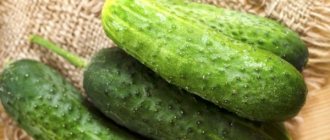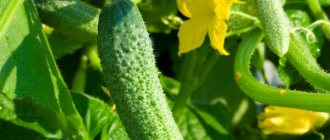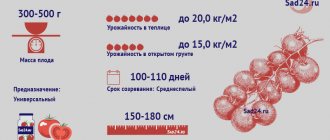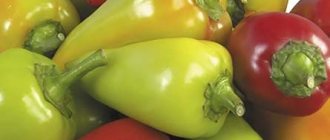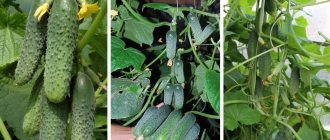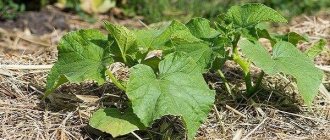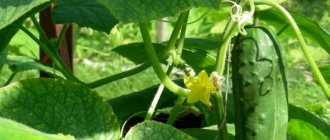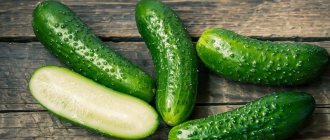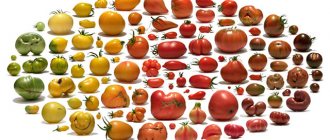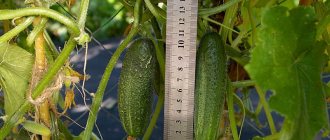The alliance is represented simultaneously by 2 originators. For an agricultural company from Rostov, this is a productive mid-season variety. Alliance from Bejo is a promising Dutch hybrid with high productivity and early ripening. Both species are popular with gardeners for their hardiness and weather resistance. They consistently produce crops in northern, southern and temperate regions.
| Landing location | Ripening time | Mode of application | Fruit length | Group | Fruit smoothness | Pollination method |
| Universal | Mid-season (56-65 days) | Universal | Medium - from 10 to 15 cm | Variety | Slightly lumpy | Parthenocarpic |
Description of the variety
Alliance f1 cucumber can be grown in any conditions and on any soil. But it should be borne in mind that seeds should be planted in open ground only when the threat of night frosts has passed.
- Flowering type: female.
- The variety is parthenocarpic.
Alliance cucumbers are mid-season - from planting to harvesting it takes about 53 days. Plants cannot be classified as tall, they can be called more medium-sized. The leaves are medium sized and have a regular shape with a slightly wavy edge. Up to three fruits can form in the leaf axil at one level.
The description of Alliance cucumbers is as follows:
- correct and even cylinder shape;
- tubercles of medium size, slightly flattened;
- the fetal neck is not long;
- the size of cucumbers is about 15 cm;
- weight - from 90 to 115 grams.
The skin has a rich green hue with light whitish stripes, as well as brown spines. Pubescence is very rare.
Cucumber Alliance F1
On the market you can find two types of Alliance cucumber varieties from two different manufacturers.
The brainchild of breeder A.A. Mashtakov. (Rostov-on-Don). The hybrid has an average ripening period. Recommended for cultivation in the central, central black earth, northern, northwestern, north Caucasian, western and eastern Siberian regions. Authorship belongs to Strelnikova T.R., Blinova T.P., Mashtakov L.Yu. and Mashtakova A.Kh.
A variety of female flowering type, parthenocarpic. Recommended for growing indoors, spring-summer rotation. It may take 51 to 54 days from germination to fruiting.
Plants are medium branched, medium tall. The leaves are medium-sized, green, slightly wavy at the edges. From 1 to 3 ovaries are formed in the leaf axil. Zelentsy are cylindrical in shape, with medium density of pubescence, medium-sized tubercles.
The shape of the fruit is somewhat elongated, cylindrical, with a short neck and small tubercles. The length reaches 15-16 cm, weight 95-115 g. The skin is green with short longitudinal stripes of white color. Sparse pubescence with white spines. High commercial yield of products at the level of 91-98%.
The hybrid is used mainly for fresh consumption, however, it also performs well when canned. Consumers note high taste qualities.
The variety is highly resistant to brown spot, powdery mildew and blight.
Mainly characterized by high marketability, stable yield and plasticity.
Selection of the Dutch company Bejo (Bejo Zaden BV). grows well in open ground.
Gherkin-type variety, bee-pollinated. It may take 44-47 days from germination to fruiting.
The bushes are medium-climbing, medium-sized, with great growth potential of the central shoot. The flowering type is mainly female. The leaves are dark green and medium in size. The leaf apparatus and root system are well developed.
The shape of the greens is cylindrical ovals with small tubercles, 6-10 cm long, weighing 70-90 g. The skin is not thick, with small side stripes of white color. White spines with dense pubescence. Marketability is 80 - 96%. The marketable yield is 151-485 centners per 1 hectare.
The Alliance variety developed by Beyo is a hybrid of universal use, excellent for canning on an industrial scale. Consumers note the high taste of the fruit.
Resistant to cucumber mosaic virus, olive spot, powdery mildew and peronospora. Heat-resistant, has a good presentation and high transport capacity.
Characteristics of the variety
Characteristics of the Alliance cucumber are as follows:
- medium climbing;
- medium-sized, with unlimited length of the central stem;
- the type of flowering is predominantly female;
- leaves are medium sized and dark green in color;
- the root system is strong, well developed;
- the fruits are perfect, regular shape with small tubercles;
- the length of cucumbers is about 7-10 cm;
- cucumber weight - up to 100 grams;
- the skin is quite thin, there are white spikes on the surface.
This variety of cucumbers is often used for canning on an industrial scale. When pickled, cucumbers remain as crisp as fresh.
General information about the variety
A hybrid variety of cucumbers appeared in Russia a couple of years ago. The new product is recommended for open ground. In the case of cultivation in temperate climate zones, it is possible to use film shelters. Description of external data and general characteristics of the plant:
- Gherkin type variety.
- Hybrid.
- The earliest bee-pollinated species, cucumbers are ready for harvest 50–55 days from planting.
- Powerful root system.
- Medium sized bush.
- Medium climbing variety.
- Great growth potential of the central shoot.
- The number of ovaries per node is 1–3 pieces.
- The pubescence consists of spines.
- The female type of flowering predominates.
- Small foliage is slightly wavy.
- Average percentage of bush branching.
- Reproduction by budding.
- Side shoots are rare.
- The first fruits are formed in the amount of 10 pieces.
- High temperature resistance.
- Good immunity to most viruses and diseases: cucumber mosaic, powdery mildew, olive spot and peronospora.
- Large percentage of yield, up to 19 kilograms per square meter of planting,
- Long fruiting period, until mid or late autumn.
- The percentage of product yield is up to 98%.
- They can withstand transportation without losing commercial quality.
Reviews from vegetable growers indicate better yield indicators in the Central and Central Black Earth regions of the country. Features and technical information about the fruits:
- Cylindrical, elongated shape.
- Length 15–16 centimeters.
- Weight up to 115 grams.
- Average density of pubescence.
- Short neck.
- Small tubercles.
- The skin is green with a small number of longitudinal white stripes.
- Rare pubescence.
- Lasting cucumber aroma.
- High taste qualities.
See also
What to do if the leaves of cucumbers are pale, what to feed themRead
Ripe fruits are preferable for fresh consumption and are used as a component for salads. Consumer reviews confirm the success of canning Alliance cucumbers.
IMPORTANT! The plant is suitable for canning on an industrial scale.
Features of cultivation
Planting this cucumber variety can be done in two ways:
- Sealed. It is necessary to begin cultivation a month before the expected date of planting in the soil. First you need to soak the planting material and wait until the roots appear. Planting is carried out to a depth of 1-2 centimeters in pre-moistened soil. It is necessary to maintain temperature conditions and timely watering. Planting of seedlings is carried out only if the soil is heated to 10 degrees.
- The seedless path. The plant is planted only if the soil is heated to 14 degrees and there are no night frosts. The recommended planting depth is three centimeters, the distance between holes is at least five centimeters.
For any of the chosen planting methods, you should pay attention to the location of the bed. It should be on a hill or flat area and have good lighting. They prefer an area between tall plants.
Landing Features
Alliance f1 grows well both in the greenhouse and in the ground. Both seedling and seed planting types are suitable for it. These cucumbers love nutritious, light soil with neutral acidity and a moderate climate.
Landing dates
Alliance F1 seedlings are planted in open ground in late May - early June. The main thing is that the earth has warmed up to 12°-14° by this time. Cucumber seeds for germination are introduced a month earlier - in the last days of April. Alliance f1 is recommended to be grown at higher elevations.
Site preparation
For planting the Alliance, an area is selected that is both unshaded and inaccessible to the winds. The description recommends that cucumber plantings should receive the maximum amount of sunlight - they should be illuminated for about 15 hours a day.
Before planting, the soil is dug up to a depth of 10 cm, treated with disinfectants and organic matter is added.
Planting seeds
It is best to germinate the seeds of the variety separately - in containers on a well-lit windowsill. Alliance f1 seeds are first kept in damp gauze until sprouts appear, then planted in nutrient soil to a depth of 2 cm.
The temperature for germination is 25°. The sprouts of cucumber varieties are transferred to open ground when 4 leaves appear.
Planting seedlings
Cucumber seedlings are brought into the plot after checking the weather forecast - there should be no frosts in the coming days. Seedlings are carefully planted in pre-prepared holes with fertilizer at the bottom so as not to damage the roots. The ideal neighborhood for a cucumber is tall corn, which can protect the seedlings from the winds.
Planting scheme
Alliance f1 cucumber seedlings are planted to a depth of about 5 cm. The ideal distance between holes is 10 cm. The width between adjacent rows, according to the description, should be 65 cm. In the case of seed planting of cucumbers, 2-3 seeds are planted in each hole.
Care
Further care for cucumbers requires compliance with simple farming rules. This plant requires feeding with complex mineral fertilizers, mandatory watering and weed removal.
The variety tolerates heat and drought well, but for high-quality fruiting it needs to be watered at least 3 times a week.
Growing rules
Selecting a location
The landing site is of great importance. Choose it so that the fruits are protected from winds, especially the southern type. It is best to plant cucumbers between tall and dense plants - this could be corn. And of course, an important factor is the sun; the area should be in direct sunlight for 15 hours.
Soil preparation
For this variety, it is very important that the soil can hold a sufficient amount of water and is loose and fertile. Since the root system of the plant is small, you can use an easy method of watering and fertilizing the plant.
All you need to do is make a small trench, 30 cm is enough, and pour water and add fertilizer there. In this way, you will save the root system from root erosion and provide the maximum percentage of fertilizer and minerals.
Care
In cold weather, organic additives will be able to warm the root system of the plant, since, when decomposing in time, they release a large percentage of heat, which goes deep into the ground. Do not forget that throughout the season it is necessary to fertilize plants with mineral and complex nutrients.
Diseases and pests
Alliance from a Dutch manufacturer is quite resistant to powdery mildew, olive spot and cucumber mosaic. But to avoid any problems with growth, it must be treated in a timely manner from pests and viruses.
Olive spot
Bejo's high quality Dutch seeds are extensively tested in different climates around the world under different growing conditions. Therefore, the seeds are resistant and tolerant to various diseases and pests. This means they can be grown using fewer chemicals, reducing the environmental impact and cost of production.
To prevent possible troubles in the form of gray rot, you can tie up cucumbers. This is the simplest and safest way that will help protect the plant from the spread of gray rot.
Did your cucumbers suffer from gray rot?
Not really
How to tie a plant correctly:
- drive pegs into the soil, the length of one should not exceed 1 meter;
- stretch a strong rope over the pegs;
- carefully take the weaving cucumbers and tie them (the same method is used for tying grapes);
- tying will save the crop from rotting and the formation of gray rot. In addition, thanks to the garter, the harvesting process will continue with a bang; you will no longer need to bend your back, because the tied cucumbers almost fall into your bucket themselves.
Description of Alliance cucumbers
The Alliance cucumber is a hybrid variety that first appeared several years ago. This species appeared on the territory of the Russian Federation two years ago from several producers, and they are slightly different from each other, but the main features are the same - excellent immunity and a high percentage of yield.
Description of Alliance cucumbers
Characteristics of the variety
Cucumber of the Alliance F1 variety is a plant that has an excellent root system, the bush germinates quickly and the first leaves can appear in just a few days. They reproduce by bunching, when all the shoots are formed on the main trunk.
Sometimes side shoots are found, but they usually do not develop to the end, and as a result, the fruits simply die without ever reaching the point of ripening. For the first time, up to 10 cucumber fruits appear on the bush, which grow to ideal weight and size. The plant can bear fruit until late autumn.
The yield of this variety is high: if there is a sufficiently large percentage of light, then almost every week you can get new cucumbers. Almost all fruits are of the female type, so there is no need to plant other types of cucumbers nearby. This type of cucumber is great for using fresh or preparing for pickling.
The Alliance Beyo variety is best used for planting in closed soil during summer rotation. From the moment of planting to the moment of harvest it will take from 50 to 55 days, sometimes it can reach 60 days if there are frosts at night.
Description of the bush
The bush is small in size with an average percentage of branching. The leaves are small in size and rich green in color; slight waviness can be seen on the edges of the leaves.
From 1 to 3 ties are formed on one foliage. This is a fairly good indicator, as experts say, the main thing is to water and collect the fruits on time so that new ones can ripen on time.
Description of the fruit
All fruits have a cylindrical shape with a slight drooping and density; small tubercles are noticeable on the skin. Unlike other cucumbers, these have a more elongated shape, with a small neck.
The length of such fruits reaches 17 cm, and their weight is 116 g. The skin of cucumbers is bright green with small white stripes that are not always noticeable. Rarely there is an omission with white spines.
Advantages and disadvantages
Alliance Beyo F1 is a variety that is known for many positive aspects, thanks to which it is popular among experienced gardeners:
- resistance to many diseases;
- excellent taste;
- excellent presentation;
- stable yield;
- can easily grow both in open ground and indoors;
- resistance to heat;
- well adapted for transportation;
- can easily withstand temperature changes.
The disadvantage of this variety is the inability to resist many diseases, for example, mosaic. Therefore, before planting, it is best to carry out comprehensive prevention by any means. Proper planting
Growing methods
The variety can be grown by seedlings and seeds
This variety can be grown in two ways:
- seedling method;
- in a seedless way.
Seedling method
This method means that before sowing the seeds, they must be sprouted about a month before planting on the site. Before doing this, the seeds need to be soaked in water so that they give some roots, so they can germinate faster in the ground.
Plants are planted in open soil only when the ground has warmed up sufficiently and there should be no frost in the near future. This period falls at the end of May and mid-June.
Seedless method
For this method of planting, seeds are already used; they must be planted in the ground, the temperature of which is not lower than 14 °C, otherwise all the seeds will simply disappear and you may not expect any fruit.
It is also important to observe the planting depth, it should be no more than 3 cm, and the distance between seedlings should be 5-10 cm. This variety can be planted next to others, it will get along well with them and even help pollinate, who exactly will play the role of pollinator – will depend on the varieties.
Reviews from gardeners
The advantages of gardeners include resistance to weather conditions and diseases. The downside is a slight lag in performance.
Many people believe that the Alliance cucumber provides a rich harvest. Alliance cucumbers are a good combination of price and quality. Seed material is relatively inexpensive, which allows you to sow a large area with this hybrid without large investments. Gardeners often plant the Alliance cucumber under the “open” sky (although the variety is also suitable for greenhouses, since it is self-pollinating). At the same time, the plants withstood the May cold and two weeks of rain without any problems. And the scorching sun, which replaced the spring cyclone, did not “cook” the plants.
Advantages and disadvantages
The Alliance hybrid is popular due to many positive qualities:
- Resistant to most cucumber diseases;
- Excellent taste characteristics;
- Stable yield;
- Versatility of cultivation;
- Heat resistance;
- Good adaptability for transportation;
The Alliance gardeners did not identify any significant shortcomings.
- Excellent tolerance to temperature changes;
- Good presentation of greens;
- Long fruiting period.
Video
You can also watch a video where they will tell you about the most successful varieties of cucumbers for open ground.
Today we were able to get acquainted with one of the most productive cucumber varieties - Alliance. Imagine that from one square meter you can harvest up to 10 kilograms of crop, and this despite the fact that the plant is not picky about planting and requires special care. The Alliance cucumber has excellent taste and can be enjoyed in fresh or salted form. Of course, the Alliance is an indispensable guest at any table, providing good and generous harvests.
Reviews from gardeners
I recently discovered Alliance cucumbers. The plant bears fruit in hot summer conditions and is not capricious. The fruits are crispy, small in size and without bitterness. I recommend!
Anna Wagner, 43 years old
I recommend Alliance cucumbers to residents of the North-West region. The plant is stress-resistant and does not require close attention. The fruits weigh 100 grams and are juicy. The family likes to eat them fresh. For the winter we wrap 5-10 cans.
Arseny Karlov, 34 years old
Delicious fruits with easy care - cucumber Alliance f1: description of the variety
The alliance is represented simultaneously by 2 originators. For an agricultural company from Rostov, this is a productive mid-season variety. Alliance from Bejo is a promising Dutch hybrid with high productivity and early ripening. Both species are popular with gardeners for their hardiness and weather resistance. They consistently produce crops in northern, southern and temperate regions.
| Landing location | Ripening time | Mode of application | Fruit length | Group | Fruit smoothness | Pollination method |
| Universal | Mid-season (56-65 days) | Universal | Medium – from 10 to 15 cm | Variety | Slightly lumpy | Parthenocarpic |
Description and characteristics of the variety
Alliance differences based on origin
| Indicators | Russian variety | Hybrid from Holland |
| Pollination | Parthenocarpic | Bee pollinated |
| Fruit | Zelentsy 12-17 cm | Gherkins 6-8 cm |
| Collection time | Average – in 56-58 days |
Fruiting is prolonged, ending only in autumn.
When there is frost, the first harvest is delayed for up to 5-7 days.
The descriptions of the bushes from both originators are similar:
- shoots of average height within 1 m;
- fruits ripen on the main trunk;
- moderate branching;
- leaves are medium-sized with wavy edges;
- the root system is well developed.
| Early – after 45-47 days | ||
| Indicators | Hybrid Alliance | Variety |
| Fetus | Gherkin | Zelenets |
| Average weight | 70-90 g | 90-120 g |
| Length | 6-8 cm | 15-17 cm |
| Form | Elongated |
Advantages and disadvantages
- stable productivity;
- good adaptation;
- resistance to powdery mildew, olive spot;
- excellent keeping quality and transportability;
- high marketability and taste rating;
- heat tolerance;
- endurance to temperature changes.
Minuses:
- below average resistance to cucumber mosaic;
- the need for preventive measures against infections.
Productivity
Productivity depending on region:
- North-West 12-15 kg;
- East Siberian 7-8 kg;
- Central 13-18 kg.
Landing
The hatched seed material is sown 1-2 pieces in peat pots or peat tablets measuring 40-44 mm. The soil for filling containers is light and nutritious. Use ready-made soil mixtures or coconut substrate.
Growing and care
The site is prepared in a sunny place without strong winds and drafts. Illumination should continue in the summer for at least 15 hours. Land requirements:
Seedling method
30-35 days before the transplant date, seeds are sown in a permanent place. To activate germination, seed material is soaked in water and activators - Zircon, Agate. They are planted in the ground at the end of May and in the first 2 decades of June.
Seedless method
The seeds are sown directly into the holes in the garden bed. Place 2 seeds in each hole. The ground should warm up to 14-15 degrees at the time of planting. When sowing, follow the planting scheme:
- the distance between the recesses is 8-10 cm;
- distance between rows 65-70 cm;
- the depth of the soil is 2-3 cm.
Rules for sowing and growing varieties
Parthenocarpic varieties of cucumbers differ little from their ordinary counterparts in the method of sowing and growing. The main thing is to follow time-tested rules.
Seedling method
By growing strong seedlings, you can ensure a high yield.
The correct scheme for obtaining strong sprouts:
- Select the highest quality, regularly shaped seeds.
- Soak for a day in a solution: 10 g of superphosphate and potassium sulfur per liter of water.
- Prepare the soil: sift the soil and sand, combine with peat in a 1:1:1 ratio. Place in containers for seedlings. Moisten and leave for two days. You can purchase the substrate in the store.
- Seeds are placed in the soil no more than 5 mm deep.
- Lighting is installed directly above the seedlings, which will appear in 5 days.
- After two true leaves appear, feed with a mixture of mineral fertilizers for cucumbers: 10 g of potassium sulfate and urea per 10 liters of water.
- Planted in the ground after the appearance of the fifth leaf.
Using the seedless method
For planting in open ground, it is better to take two-year-old seeds that have better germination and a tendency to form female flowers. You cannot sow cucumbers after tomatoes or next to them. The best neighbors: carrots, dill, peas, radishes, cabbage.
Did you know? Emperor Napoleon was very fond of cucumbers. He promised to generously reward the person who came up with a way to keep vegetables fresh for a long time, but this reward never went to anyone.
Rules for sowing in the ground:
- The bed is located in a place protected from drafts.
- Fertilize the soil in autumn with manure and humus.
- Water the day before and loosen the soil immediately before planting.
- Seeds are planted to a depth of 3 cm. Distance: 50x30 cm.
- Cover the bed with film until shoots appear.
- When sowing early (before mid-May), it is better to leave a shelter overnight to protect against possible frosts on the ground.
Description of culture
Hybrid Patti f1 is a self-pollinating crop; pollen transfer for plant propagation occurs independently. This allows the species to be cultivated even in a greenhouse, where access to insects is minimized.
Distinctive features
The hybrid was bred specifically for the Russian climate. It is resistant to temperature fluctuations, prolonged rains, and tolerates dry weather and heat. The fruits set throughout the summer, this period lasts until the first frost.
Patti can be grown on a balcony and loggia; the yield will not suffer at all.
Composition, properties, benefits, calorie content
The calorie content of the fruit is 15 kcal per 100 g of product. In cucumbers, 95% is structured water. It is very useful for the human body, as it flushes the kidneys and removes unnecessary toxins, waste and heavy metal salts. The fruits also contain beta-carotene, vitamins A, B1, B2, C, PP.
Patti contains minerals:
- potassium;
- magnesium;
- zinc;
- copper;
- manganese;
- iron;
- iodine;
- chlorine;
- chromium;
- sodium;
- phosphorus.
Frequent consumption of fresh cucumbers has a positive effect on the thyroid gland, prevents the formation of cholesterol plaques on the walls of blood vessels, which serves as an excellent prevention of cardiovascular diseases.
Characteristics
Features of the hybrid fruits are their small size and weight. Patti is a representative of the gherkin type, which is characterized by small fruits up to 10 cm long and 2 cm in diameter. Cucumbers will not grow larger than the genetic size, so there are no barrel-shaped fruits.
The skin of cucumbers is thin and glossy. The color at technical maturity is bright green; there are short and thin light stripes at the top of the fruit. The vegetable is not suitable for long-term storage, since the thin shell does not protect well from moisture loss. The finished harvest should be consumed or processed within 2-3 days.
The pulp is tender, juicy and crispy. The seed chamber occupies up to 2/3 of the cucumber. There are no seeds in its capsules. The taste is high: since the pulp contains sugary substances, its taste is sweet.
The peculiarity of the Patti hybrid is its early ripeness. The first harvest is harvested 1.5 months after sowing the seeds. Mass fruiting occurs 2 weeks from the beginning of cucumber ripening. From 1 m² you get 5–7 kg of fruit.
Agricultural technology for caring for cucumbers
To obtain high yields when caring for a hybrid, it is recommended to carry out basic agrotechnical practices, which are aimed at regular moistening, systematic feeding of bushes, and treating them from pests and diseases.
Watering and fertilizers
Cucumbers are a moisture-loving crop that requires high-quality and abundant watering.
It is especially important to provide vegetables with moisture during the period of their flowering, fruit formation and active growth. It should be noted that moisture deficiency has a negative effect on the taste of fruits; they begin to taste bitter
Important! It is strictly forbidden to use cold water from a well for irrigation. Settled, warm water is suitable for moisturizing plants.
Do not forget about regular fertilizing of the crop, which should be done once every 10 days. To feed cucumbers, it is better to use mineral preparations that will activate the formation and growth of fruits. Experts advise combining fertilizer application with weeding.
Another important aspect of cucumber care is pinching out young stems. This procedure has a beneficial effect on vegetable yield indicators.
Control and prevention of diseases and pests
The described variety is characterized by a strong immune system and is rarely susceptible to disease. In rare cases, violations of basic rules of agricultural technology and unfavorable weather conditions may affect:
- powdery mildew - manifests itself in the form of a white, flour-like coating that forms on the leaves and stems;
- brown spot - the disease is easily recognized by the formation of brown spots on the leaf blades, which gradually increase and affect the entire leaf;
- white rot - can be recognized by the appearance of a white coating on the leaves and stem, which rots during development.
Preventive treatment of the plant with modern fungicides, as well as some important measures, helps combat diseases:
- compliance with crop rotation;
- regular weeding of the soil and removal of weeds;
- timely removal of vegetation from beds;
- control of soil moisture in the area.
Among insect pests, the following have a particularly harmful effect on cucumbers:
- aphids - small insects parasitize on the underside of the leaf blade, attack flowers, ovaries and fruits;
- spider mite - the presence of a parasite can be recognized by the formation of a characteristic small white cobweb at the bottom of the leaf;
- slugs - the main activity of pests occurs at night, when they devour the green mass of the plant and spoil the fruits.
Broad-spectrum insecticidal preparations, which are sprayed on bushes several times a season, are highly effective in controlling and preventing pests.
Important! A month before harvesting, any disinfection must be stopped.
Agricultural technology and care
Sow seed material at the end of April or beginning of May, when the soil warms up to +14-15°C. Place 2-3 seeds per hole. Planting depth is 3-4 cm. The interval between seeds in a hole is 5 cm, between holes is 20 cm, and in rows is 40 cm. Plants love sunlight and do not like drafts. Choose a place for cucumbers on the south side. To protect against wind blowing, plant the plants near the corn, which will serve as a protective barrier against drafts. In the spring, two weeks before sowing seeds in the garden bed, fertilize it with compost or rotted manure (1 bucket per 1 m²), water it generously and dig up the soil.
Water the plants no more than once every two days. To reduce evaporation, the soil under the root system can be mulched with dry hay, straw, and sawdust. Water consumption per bush is 3-4 liters. Keep an eye on weeds in your garden. Don't let it spread. It attracts pests, which then move to cucumbers and other vegetables. When the main vine of the plant reaches 40 cm, tie it to a support or pull the net.
Feed the plants at least twice during the growing season. The first time the cucumber plant throws out the first three leaves. Use a solution based on nitrogen, potassium, phosphorus (15 g each) and water (10 l) for fertilizer. Consumption half bush 1 l. Use the prepared mixture immediately after preparation. Apply the second feeding while the plant is flowering. Use baker's yeast solution. Take 8 liters of warm water, dissolve 15 g of baker's yeast and a liter of wood ash. Infuse the resulting mixture for 2 hours in a warm place. After that, water the plants under the bush, consumption is 1 liter.
Growing methods
The variety can be grown by seedlings and seeds
This variety can be grown in two ways:
- seedling method;
- in a seedless way.
Seedling method
This method means that before sowing the seeds, they must be sprouted about a month before planting on the site. Before doing this, the seeds need to be soaked in water so that they give some roots, so they can germinate faster in the ground.
Plants are planted in open soil only when the ground has warmed up sufficiently and there should be no frost in the near future. This period falls at the end of May and mid-June.
Seedless method
For this method of planting, seeds are already used; they must be planted in the ground, the temperature of which is not lower than 14 °C, otherwise all the seeds will simply disappear and you may not expect any fruit.
It is also important to observe the planting depth, it should be no more than 3 cm, and the distance between seedlings should be 5-10 cm. This variety can be planted next to others, it will get along well with them and even help pollinate, who exactly will play the role of pollinator – will depend on the varieties.
